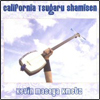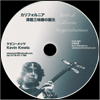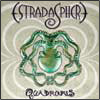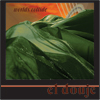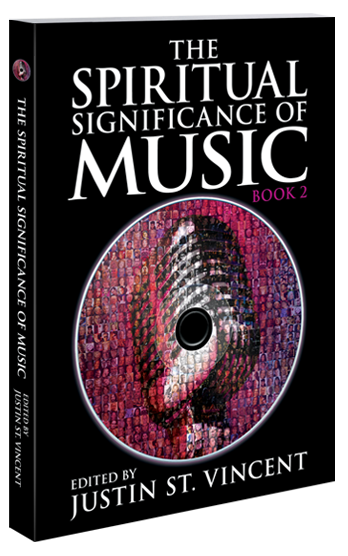GOD OF SHAMISEN |
|
GOD OF SHAMISEN is a prog-rock funk-fusion band from Santa Cruz, California, who are responsible for pioneering a new style of California Tsugaru Shamisen in the twenty-first century. The band is fronted by Shamisen virtuoso Kevin Kmetz, who plays the Tsugaru Shamisen, and the Mugen 21 Electric Shamisen. This three-string lute-like instrument originates from the Tsugaru region of Northern Japan. It is usually performed in a folk style, yet the Spirit of Shamisen is often compared to jazz, especially when approached from an improvisational perspective. Kevin Kmetz has produced an illustrated history of Tsugaru Shamisen for those interested in learning more about this fascinating musical instrument. In addition, Daijo Kazuo’s book “The Birth Of Tsugaru Shamisen Music” provides comprehensive information on the creative marginality that stimulated Shamisen popularity into one of the most loved traditional instruments in Japanese culture. God Of Shamisen is Kevin Kmetz [Shamisen], Mark Thornton [Guitar & Bass], Dave McCoy [Guitar & Bass], and Lee Smith [Drums]. During their rare live shows, band members often encourage musician friends to join them for special guest appearances. These opportunities provide a perfect platform to explore new territory in creative live performances. God Of Shamisen members have also experienced diverse musical terrains by recording releases with Secret Chiefs 3, Estradasphere, El Douje, and the Fishtank Ensemble. Kevin Kmetz also performs lively Shamisen music with bilingual storyteller Megumi, plus he provides private lessons and group workshops to students of Shamisen. More Shamisen-influenced music can be discovered through the Japanese bands Yoshida Brothers, Hiromitsu Agatsuma, and Jammin’ Sensu. God Of Shamisen have drawn their inspiration from many Tsugaru Shamisen masters, namely Takahashi Chikuzan, Shirakawa Gunpachiro, and John Zorn-collaborator Shinichi Kinoshita. God Of Shamisen compositions are available on the “California Tsugaru Shamisen” release, recorded in early 2005 at the Estradasphere studios in Soquel, California. Fishtank feature two tracks, “Ringo Bushi” and “The Last Shamisen Master”, from their debut release “Super Raoul”. Secret Chiefs 3‘s “The 4 – Great Ishraqi Sun” is taken from their fourth album “Book Of Horizons”, and Estradasphere‘s “Mekapsis Yitonisa”, based on the traditional Greek composition “Kalamatiano”, that introduces their fifth release “Quadropus” on Mimicry Records. The “California Tsugaru Shamisen” album also features Flamenco guitarist El Douje contributing his composition “Colision De Mundos” from the accomplished album “Worlds Collide”. God Of Shamisen anticipate producing their own full-length album and introducing the world to their cross-fertilization of traditional and contemporary styles. |
|
CD
|
| ARTIST: Watsonville Taiko ALBUM: Futabashira LABEL: [Independent Release] RELEASED: 2006 DURATION: 44:57 – 7 Tracks |
Watsonville Taiko and Kevin Kmetz collaborate in this contemporary collision of Taiko Drumming featuring Tsugaru Shamisen. A passionate and percussive musical journey into the joyous exploration of Japanese music. Recommended tracks are “Asayake (Sun Rise)” and “Kaze Ni Fukarete (Sent By Winds)”. “Futabashira (Two Pillars)” is a spiritual encounter with ethereal vocal harmonies and inspiring instrumentation. Watsonville Taiko is a creative community of composers giving listeners a greater appreciation for Japanese music, myth, folklore, dance, and theater.
|
| ARTIST: Kevin Masaya Kmetz ALBUM: Great Masters Of Modern Shamisen LABEL: [Independent Released] RELEASED: 2006 DURATION: 59:24 – 17 Tracks |
Great Masters Of Modern Shamisen is a creative compilation from Kevin Kmetz showcasing new works by some of today’s most celebrated Shamisen masters. God Of Shamisen perform a brilliant track called “California Burrito Dog Attack!”, “The Kidnapper” features Fishtank Ensemble together with guitarist El Douje, and “Mary Jane” is another incredible song scripted by vocalist Danyl Johnson. This CD also contains several original songs from Tsugaru Shamisen protégé Mike Penny. Kevin Kmetz also covers the legendary Baroque composer Johann Sebastian Bach’s “Toccatta”. |
| ARTIST: Kevin Masaya Kmetz ALBUM: California Tsugaru Shamisen LABEL: Shamisen Katoh RELEASED: April 3, 2005 DURATION: 55:07 – 14 Tracks |
California Tsugaru Shamisen is a compilation showcasing music performed by Shamisen virtuoso Kevin Kmetz. This collection includes collaborations with Secret Chiefs 3, Estradasphere, El Douje, God Of Shamisen, and new material from Fishtank courtesy of Trey Spruance’s Mimicry Records. A sonic fusion of Japanese folk, Romanian gypsy, Flamenco grooves, traditional music, and surf-rock styles. Album favourites include Fishtank’s “The Last Shamisen Master” and God Of Shamisen’s “Dragon String Attack!” |
DVD Reviews |
| DIRECTOR: Nao Nakazawa FILM: Birth Of California Tsugaru Shamisen COMPANY: [Independent Release] RELEASED: 2005 DURATION: 41:01 |
Birth Of California Tsugaru Shamisen is a documentary profiling the incarnation of a new music style spearheaded by Santa Cruz musician Kevin Kmetz. This DVD is presented in Japanese and introduces great live performances from God Of Shamisen, Estradasphere’s “Turkish Song” and their “Search For Sheriden”, Secret Chiefs 3’s “The Four (The Great Ishraqi Sun)”, Fishtank’s “Bordeas” and “The Last Shamisen Master”. Kevin Kmetz also performs “Greatness” with proficient Shamisen performer Mike Penny, who has developed an original style and chord theory in California Tsugaru Shamisen. Extras include an additional thirty minutes of live video with God Of Shamisen’s “Dragon String Attack!”, Estradasphere’s “Corporate Merger”, Secret Chiefs 3’s “The Three (Afghan Song)”, and a fantastic composition from Fishtank. |
Selected Discography |
| ARTIST: Estradasphere ALBUM: Quadropus LABEL: Mimicry Records RELEASED: October 30, 2003 DURATION: 62:37 – 10 Tracks |
ARTIST: Secret Chiefs 3 ALBUM: Book Of Horizons LABEL: Mimicry Records RELEASED: May 25, 2004 DURATION: 52:51 – 14 Tracks |
| ARTIST: Various Artists ALBUM: Mimicry Sampler 2004 LABEL: Mimicry Records RELEASED: 2004 DURATION: 71:15 – 17 Tracks |
ARTIST: El Douje ALBUM: Worlds Collide LABEL: [Independent Release] RELEASED: November 2004 DURATION: 75:27 – 13 Tracks |
| ARTIST: Kevin Masaya Kmetz ALBUM: California Tsugaru Shamisen LABEL: Shamisen Katoh RELEASED: 2005 DURATION: 55:07 – 14 Tracks |
ARTIST: Fishtank ALBUM: Super Raoul LABEL: Mimicry Records RELEASED: August 2005 DURATION: 62:42 – 13 Tracks |
| ARTIST: Kevin Masaya Kmetz ALBUM: Great Masters Of Modern Shamisen LABEL: [Independently Released] RELEASED: 2006 DURATION: 59:24 – 17 Tracks |
ARTIST: Watsonville Taiko ALBUM: Futabashira LABEL: [Independent Release] RELEASED:2006 DURATION: 44:57 – 7 Tracks |
Exclusive Interview |
|
Justin St. Vincent from Xtreme Music received responses to an e-mail interview with Kevin Kmetz on June 9, 2005. Xtreme Music: God Of Shamisen are pioneering a new sound in the Santa Cruz musician community. How exactly did God Of Shamisen form, and when did you start working together as band? Kevin Kmetz: Since I was a teenager I noticed that Tsugaru Shamisen was a truly “powerful” music. The ferocious style in which the Tsugaru masters strike the strings sometimes reaches a “violent” level! For years I wondered how it would sound to combine the power and passion of Tsugaru Shamisen with the fire and fury of modern metal. To do this I realized that the key element for making it work would be the relationship between the Shamisen and the drums. I have always been a huge fan of death metal drumming and had a strong desire to hear this style with my Shamisen playing! I searched for quite a while and then suddenly in 2004, as if like an answer from the Gods, a talented and energetic drummer named Lee Smith from Georgia moved right next door to me to join and work with the band Estradasphere. Once Lee arrived I knew I would have to ask him to help me form history’s first Shamisen based rock band in America!.. Many years ago I lived in Southern California, during that time I met a talented young musician named Dave McCoy. We remained friends for years and later we both ended up moving to Santa Cruz. Dave and I already had quite a few jams and grooves we had been throwing around so when forming the band it was easy to find material to build from. Dave and I got together and worked out the first God Of Shamisen set, about a twenty to twenty-five minute set, in about one or two evenings. From playing in the Santa Cruz based band Estradasphere I also got to know Mark Thornton who did a brilliant job with the Estradasphere DVD “Passion For Life“, and often did projections and other effects for live shows. One day Mark was throwin’ down a jam on the bass guitar. It was like a funky thing in some harmonic minor key. There was something to it! I heard it and I said “Wow! you know… we should all make this band and call it God of Shamisen!” We officially formed in the Fall of 2004 and had our first show in Santa Cruz! Xtreme Music: Please tell us about the writing processes involved in God Of Shamisen’s original compositions. Kevin Kmetz: Dave McCoy and myself will often sit down and go over grooves until we find something kind of wacky to throw in, or come up with some kind of melody or theme. I really like the idea of creating a series of themes or tunes, and having them all relate somehow in the end. The song “Dragon String Attack!” is actually much longer than it appears on the CD. The entire piece is a departure and return to the main neo-classical Japanese-rock theme that kicks in at the start of the song. At the very end we do a long build up and bring that same theme back in a climactical-rock fashion. Other lesser themes are also coming in and out of the composition as it develops. The effect is similar to following a good story with characters developing and transforming throughout their experiences. Xtreme Music: What innovative production techniques does God Of Shamisen incorporate into your recorded music? Kevin Kmetz: There is actually nothing too innovative about what we have done so far in the studio. It has pretty much been a combination of direct inputs and standard micing. I did do some overdubbing but most of it is straight forward, like when we play live! Kevin Kmetz: We all played through the track with the Electric Shamisen going direct into the computer. Later I went back and overdubbed the entire Shamisen part into a mic. The final recording is a combination of both. there are some keyboard samples in there as well, towards the end. It is one of our favorite songs to play live, and almost always results in someone in the audience screaming at the top of their lungs with a mixture of sheer delight and terror as the sound of death-Shamisen rips through their soul for the first time!!! Xtreme Music: The band often invite guest musicians to join you for live appearances. How have your live performances been going, and what has the crowd reaction been like? Kevin Kmetz: Our guests have ranged from rappers to shredding guitarists. We are also hoping for Accordian and Violin guests to join our shows. Adam and Timba from Estradasphere, and anyone else who wants to rock with God Of Shamisen! I am personally looking forward to doing a few things with vocals in the future. Our live shows have been a blast so far! Of course we have had good and bad shows. One of best was the other night at a place called the Aptos Club [May 22, 2005 Aptos (CA), Aptos Club]. We rocked that place silly.. Kevin Kmetz: For Shamisen my biggest influence and inspiration comes from my teacher Akihito Narumi, leader of the eclectic Japanese ensemble called Shirakami. I would also like to mention some of the new generation of young Shamisen heroes who have inspired me, and who are now making waves in Japan’s ever evolving popular music scene: Asano Sho – winner of Japan’s 2004 and 2005 Tsugaru Shamisen championship tournament in Hirosaki City, the Shibatta Kyodai – one brother and two sisters with unbelievable Shamisen virtuosity, and Kaoru Osanai – leader of the underground Shamisen metal scene in northern Japan. Xtreme Music: The performance and sound of the Shamisen has historically been associated with alternative states of consciousness, and even submission to the spiritual realm. How does your performance style of Shamisen reflect or differ from this perspective? Kevin Kmetz: I think the name of the band itself is somewhat a reflection and tribute to this aspect of the instrument. When Nitaboh, the blind Shamisen player first created Tsugaru style Shamisen he developed his training methods by becoming involved in the Shamanic arts of Northern Japan. In the Tsugaru region the art of the Itako, a specific type of shamanism was banned and many of the female practitioners were forced to give up their art and go into marriage with various men. Nitaboh married one of these female shamans and from her learned the secret arts of the Itako Trance. In this state it is said that one empties oneself eventually becoming a vessel for the Gods and Spirits to speak, move, or play through. Tsugaru Shamisen is therefore an art born from the altered “trance” state of the Northern Japanese Itako shaman! In God of Shamisen we have done things here and there in our live shows to reflect this aspect as well. One thing we used to do on stage was to suddenly stop playing music completely and sit down in a meditative state while rubbing metal bowls with a wooden stick to produce a strange ringing effect. We would do this for exaggeratedly long periods of time sometimes just to confuse people! Xtreme Music: “California Tsugaru Shamisen” features collaborations with El Douje, Estradasphere, Fishtank, and Secret Chiefs 3. What has it been like working with each of those bands? Kevin Kmetz: I had been a huge fan of Estradasphere before joining the group so it is extremely thrilling to perform with these guys! The same goes for Secret Chiefs 3. El Douje is another amazingly talented musician who also plays in Fishtank. I definately owe the development of the new California-style Tsugaru Shamsien to these groups. Having shredders around you constantly is definately an inspiration for anyone seeking do develop his or her musicianship. Xtreme Music: Your music has featured on several releases for Trey Spruance’s Mimicry Records. How did you first meet Trey Spruance, and what experiences can you share from working with him in both a studio and live context? Kevin Kmetz: I first met Trey Spruance through Estradasphere. The first day I went up to his place to record I remember planning to meet him around noon. We ended up sitting around talking and drinking an extremely strong Turkish coffee for about 5 hours and finally around 17:30 started recording. I had never really worked with quarter tones before that time, and I remember how I had to put some tape on the back of my Shamisen’s fingerboard in order to locate them all! Xtreme Music: For those who enjoy God Of Shamisen, what essential music recommendations can you provide? Kevin Kmetz: Besides Kaoru Osanai there really is not too much out there in the area of Metal Shamisen. However, if you just like the sound of Shamisen and want to hear some of today’s top players I can recommend Hiromitsu Agatsuma, Shinichi Kinoshita, Shirakami (with my teacher, Akihito Narumi). Nitta Oyako, featuring Masahiro Nitta and Hiroshi Nitta, who played the Evil Shamisen Lord in Japan’s recent major motion picture release called “Overdrive”! If you are interested in the old school “Traditional” Tsugaru Shamisen there are a whole list of masters who have released records. Takahashi Chikuzan is probably one of the most prominant. If you can find recordings of Kida Rinsho, Shirakawa Gunpachiro, Fukushi Masakatsu, Mihashi Michiya, or Yamada Chisato, you have struck gold in the realm of the Shamisen Gods! Xtreme Music: What are your plans for projects and musician collaborations in the near future? Kevin Kmetz: I am currently planning a new CD for release in 2006. This will feature new God Of Shamisen material and many collaborations with various artists around the San Francisco Bay Area. But my biggest current project is teaching. I am attempting to get people interested enough in this instrument to try it out for themselves, and am hoping that someday people will look back at this time of creation in the same way that we are now looking back at Nitaboh and his followers. Just as Nitaboh created a new style of Shamisen on the streets of Tsugaru, I hope someday people will celebrate the further development of the Shamisen as it existed on the streets of California, USA in the early part of the 21st century! |


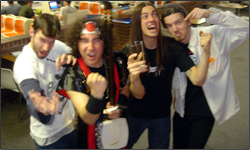
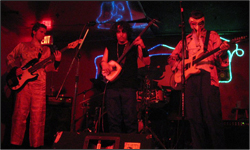 Photo Credit: Adam Stacey, Ursula Pfitzer & Rick Audet
Photo Credit: Adam Stacey, Ursula Pfitzer & Rick Audet

